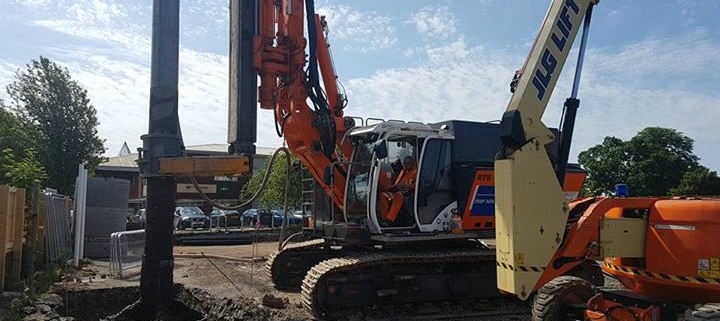Treatment of Landfill Sites and Contaminated Ground Using Soil Stabilisation
The remediation of contaminated land including landfill sites through soil stabilisation ground remediation methods has demonstrated significant time efficiency and cost-effectiveness in mitigating contamination risks. It is crucial to note that this approach treats contaminants in situ.
By stabilising the soil through the incorporation of appropriate binders, which encapsulate the contaminants, soil mixing effectively prevents these harmful substances from adversely affecting the surrounding environment. This method has proven to be a successful strategy for addressing contaminated land.
Advantages of Soil Mixing/Soil Stabilisation
In contrast to other remediation techniques, soil stabilisation allows for the reuse of existing soil rather than necessitating the disposal of contaminated material and its replacement with new soil. Instead, the contaminated soil is mixed with appropriate binders to eliminate the risks it initially posed.
Disposal of contaminated soil typically incurs significantly higher costs compared to treatment, which offers cost and time certainties that are often prioritised by project managers.
Additional benefits of soil mixing include:
– Rapid achievement of results
– Effective treatment of persistent contaminants, such as heavy metals
– Applicability in situ so less vehicle movements on site improving environmental and health and safety.
– Enhancement of the structural properties of the soil
It is a cost-effective ground improvement method that offers energy efficiency and can be integrated into a wide range of construction projects, regardless of the existing soil conditions on-site.
Successful Projects
One project undertaken by Deep Soil Mixing involved a site that had contamination due to years of timber treatment which led to high levels of creosote in the soil, causing problems for neighbours and future development of the site. The remediation solution was centred around the in-situ soil mixing using particular binders that helped to neutralise the creosote and also aided future foundations through the soil stabilisation.
Another remediation of a contaminated site involved a new housing development which was on a brownfield site with historical contamination in one part of the site. The original plan was to cart off site and dispose in land fill.
Moving the problem from one location to another was both expensive and not environmentally friendly. Deep Soil Mixing Ltd was approached and able to mass mix the area, improving the geotechnical strength of the ground to enable the road to be built but also lock in the contaminants to reduce future leaching. This resulted in an environmental success and a huge cost saving for the client. We won an Institute of Highways Award for Sustainability on this project.
Soil mixing has also been effective in the treatment of landfill sites. Many landfill sites have previously been viewed as unviable for development due to their former use as a domestic and inert waste landfill. Using soil mixing as well as dealing with contamination, soil mixing also has the added value of being able to improve the physical engineering properties of the ground which offers a very cost-effective way of dealing with landfill sites, brownfield sites/marginal land in a single process.
Take a look at some of the other contaminated land projects we have undertaken here
Types of Soil Mixing
Soil mixing can be utilised in key applications for contaminated land including:
- Stabilisation – involves altering the properties of the soil to mitigate contamination risks.
- Solidification – immobilisation and treatment of organic and inorganic contaminants
- Impermeable cut-off walls – containment of contaminants within an identified area of pollution
- Permeable reactive barriers (PRB’s) – for treatment of contaminated
ground water
These methods utilise agents to bind and enhance the contaminated soil.
Soil Mixing Binders/Agents
The choice of agent or binder for treating contaminated soil is influenced by several factors, including:
– pH levels
– Type of contaminant
– Soil characteristics
– Desired target reduction
Treatability Study
The cornerstone of successful remediation through soil mixing lies in selecting the appropriate binder. This process requires time and a thorough trial period to identify the optimal solution.
Contaminants Addressed by Soil Mixing
Soil mixing techniques are effective in treating a variety of contaminants, including:
– Asbestos
– Inorganic corrosives
– Metals
– Metalloids
– Solid organics, such as plastics and resins
– Inorganic cyanides
– Polychlorinated biphenyls (PCBs)
– Polycyclic aromatic hydrocarbons (PAHs)
Deep Soil Mixing Ltd: Your Partner in Remediation
Each contaminated site presents unique challenges, necessitating tailored remediation solutions. These solutions are meticulously designed to consider the specific site conditions and the characteristics of the contamination. A comprehensive approach is employed, incorporating laboratory tests, field trials, and ongoing monitoring throughout the implementation of the soil mixing remediation works.
If you have a specific site or project in mind, we invite you to consult with us to identify the ideal solution. From assessing the contaminants present in the site soil and ensuring quality control during laboratory testing to selecting the appropriate binder and overseeing the application in situ or ex situ, we are committed to achieving the objectives of your soil mixing project.





